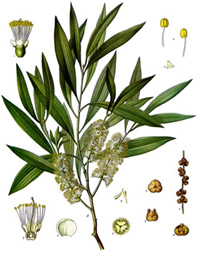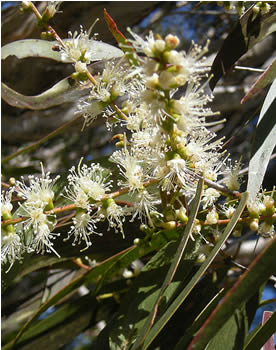Cajeput Melaleuca leucadendron, M. leucadendra
- Common Names
- Cajeput Oil , Weeping tea tree, weeping paperbark
- Botanical Name
- Melaleuca leucadendron, M. leucadendra
- Syn. Melaleuca minor
- Family
- MYRTACEAE
Medicinal Uses & Benefits of Cajeput Oil
![]() How to Use|
Side Effects |
Plant & Garden|
Aromatherapy Oil |
How to Use|
Side Effects |
Plant & Garden|
Aromatherapy Oil |
- Medicinal Uses: * Aromatherapy
* Arthritis
* Bronchitis
* Colds
* Congestion
* Cough
* Eczema
* Gout
* Insect Repellent
* Lice
* Pain Relief
* Rheumatoid_arthritis
* Sinus
* Sore Throat
- Properties: * Analgesic * Antibacterial * Astringent * Calm * Diaphoretic * Expectorant * Febrifuge * Insect repellents * Rubefacient * Vulnerary * Warm
- Parts Used: Essential Oil
- Constituents: essential oil:alpha-terpineol, azulene, benzaldehyde , cajeputol ,nerolidol, limonene
How to Use: Cajeput
The key use of cajeput is to relieve stiff, aching joints caused by rheumatism. Cajeput oil is traditionally mixed with camphor as an external rub for arthritis and gout.
Cajeput is antibacterial and clears congestion making it a good inhalant oil for colds and sinus infections. The sweet scent of cajeput uplifts the spirit while it cleanses the air.
Apply the cajeput oil externally as first aid for burns, cramps, colic, earache, headache, muscle pain, and toothache. Cajeput is an astringent oil that can benefit oily skin and help clear eczema.
In short Cajeput can be used in as many applications as the closely related Melaleuca alternifoliatea, tea tree oil, but with more caution as it is more irritating to the skin in high doses and cannot be applied undiluted.
Preparation Methods & Dosage :Cajeput oil is to be used externally. Use in low concentrations, and always dilute before applying to skin.
Cajeput Remedies
Cajeput : Essential Oil Profile
Cajeput essential oil is distilled from the aromatic leaves and twigs of the paperbark tree.
Cajeput Side Effects: Not indicated for those with kidney problems. Never apply to skin undiluted.
Plant Description

Koehler's Medicinal-Plants (1887)
Melaleuca leucadendron grows in disturbed areas, forming dense stands, and is widely cultivated for oil extraction.
- Flowers/Fruit/Seeds:Slender, creamy white flower spikes, 2- 6 in long
- Plant Class:Large Half hardy to tender evergreen tree
- Bark: Pale, peeling bark gives rise to common name paperbark tree Leaves:Slender drooping branches, narrow, pointed leaves.
- Preferred Habitat:Wetlands
- Flowering Season:summer and autumn
- Distribution:Native to northern Australia, southern New Guinea, and the Moluccas.
Regional Traditions :Australia * Southeast Asia *
Related Species
Tea Tree Melaleuca alternifolia
Niaouli Melaleuca quinquenervia
History and Traditions & Folklore
Cajeput was introduced to Europe from Indonesia in the early seventeenth century but was rare and expensive until the Dutch colonized the Moluccas. First mentioned in France in 1876 as having antiseptic properties.1- Maud Grieve. "A Modern Herbal" Harcourt, (1931) Used as a stimulating expectorant in chronic laryngitis and bronchitis, as an antiseptic in cystisis and as an anthelmintic for round worms, also used in chronic rheumatism. Applied externally, it is stimulant and mildly counter-irritant and is usually applied diluted with 2 parts of olive oil or turpentine ointment. Used externally for psoriasis and other skin affections. ,
- Hasnain Walji, Ph.D.. "Healing Power of Aromatherapy,The " Prima Lifestyles, (1996) ,












